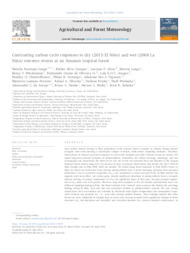Contrasting carbon cycle responses to dry (2015 El Niño) and wet (2008 La Niña) extreme events at an Amazon tropical forest.
Contrasting carbon cycle responses to dry (2015 El Niño) and wet (2008 La Niña) extreme events at an Amazon tropical forest.
Author(s): RESTREPO-COUPE, N.; CAMPOS, K. S.; ALVES, L. F.; LONGO, M.; WIEDEMANN, K. T.; OLIVEIRA JUNIOR, R. C. de; ARAGÃO, L. E.; CHRISTOFFERSEN, B. O.; CAMARGO, P. B.; FIGUEIRA, A. M. S.; FERREIRA, M. L.; OLIVEIRA, R. S.; PENHA, D.; PROHASKA, N.; ARAUJO, A. C. de; DAUBE, B. C.; WOFSY, S. C.; SALESKA, S. R.
Summary: Land surface models diverge in their predictions of the Amazon forest's response to climate change-induced droughts, with some showing a catastrophic collapse of forests, while others simulating resilience. Therefore, observations of tropical ecosystem responses to real-world droughts and other extreme events are needed. We report long-term seasonal dynamics of photosynthesis, respiration, net carbon exchange, phenology, and tree demography and characterize the effect of dry and wet events on ecosystem form and function at the Tapajós National Forest, Brazil, using over two decades of eddy covariance observations that include the 2015–2016 El Niño drought and La Niña 2008–2009 wet periods. We found strong forest responses to both ENSO events: La Niña saw forest net carbon loss from reduced photosynthesis (due to lower incoming radiation from increased cloudiness) even as ecosystem respiration (Reco) was maintained at mean seasonal levels. El Niño induced the opposite short-term effect, net carbon gains, despite significant reductions in photosynthesis (from a drought-induced halving of canopy conductance to CO2 and significant losses of leaf area), because drought suppression of Reco losses was even greater. However, long-term responses to the two climate perturbations were very different: transient during La Niña –the forest returned to its “normal” state as soon as the climate did, and long-lasting during El Niño –leaf area loss and associated declines in photosynthetic capacity (Pc) and canopy conductance were exacerbated and extended by feedbacks from higher temperatures and atmospheric evaporative demand and persisted for ?3+ years after normal rainfall resumed. These findings indicate that these forests are more vulnerable to drought than to excess rain, because drought drives significant changes in forest structure (e.g., leaf-abscission and mortality) and ecosystem function (e.g. reduced stomatal conductance). As future Amazonian climate change increases frequencies of hydrological extremes, these mechanisms will determine the long-term fate of tropical forests.
Publication year: 2024
Types of publication: Journal article
Unit: Embrapa Eastern Amazon
Observation
Some of Embrapa's publications are published as ePub files. To read them, use or download one of the following free software options to your computer or mobile device. Android: Google Play Books; IOS: iBooks; Windows and Linux: Calibre.
Access other publications
Access the Agricultural Research Database (BDPA) to consult Embrapa's full library collection and records.
Visit Embrapa Bookstore to purchase books and other publications sold by Embrapa.

